The Witcher 3: Wild Hunt Review
A high water mark not only for the Witcher series, but for the entire genre of open world RPGs
It is not uncommon these days to find Role Playing Games that boast playtime totals of over 100 hours. In most cases, the quests in these RPGs are divided into story quests which receive most of the attention, a handful of well-constructed side missions that match this quality, and then a whole slew of repetitive side content that is in place for the sole purpose of padding the number of hours it theoretically takes to complete the whole experience. My usual stance towards these quests is that if the developer didn’t put much effort into crafting them, I won’t put in the time or effort to complete them, and as such I have found myself often finishing these “100+ hour games” in half as much time or less.
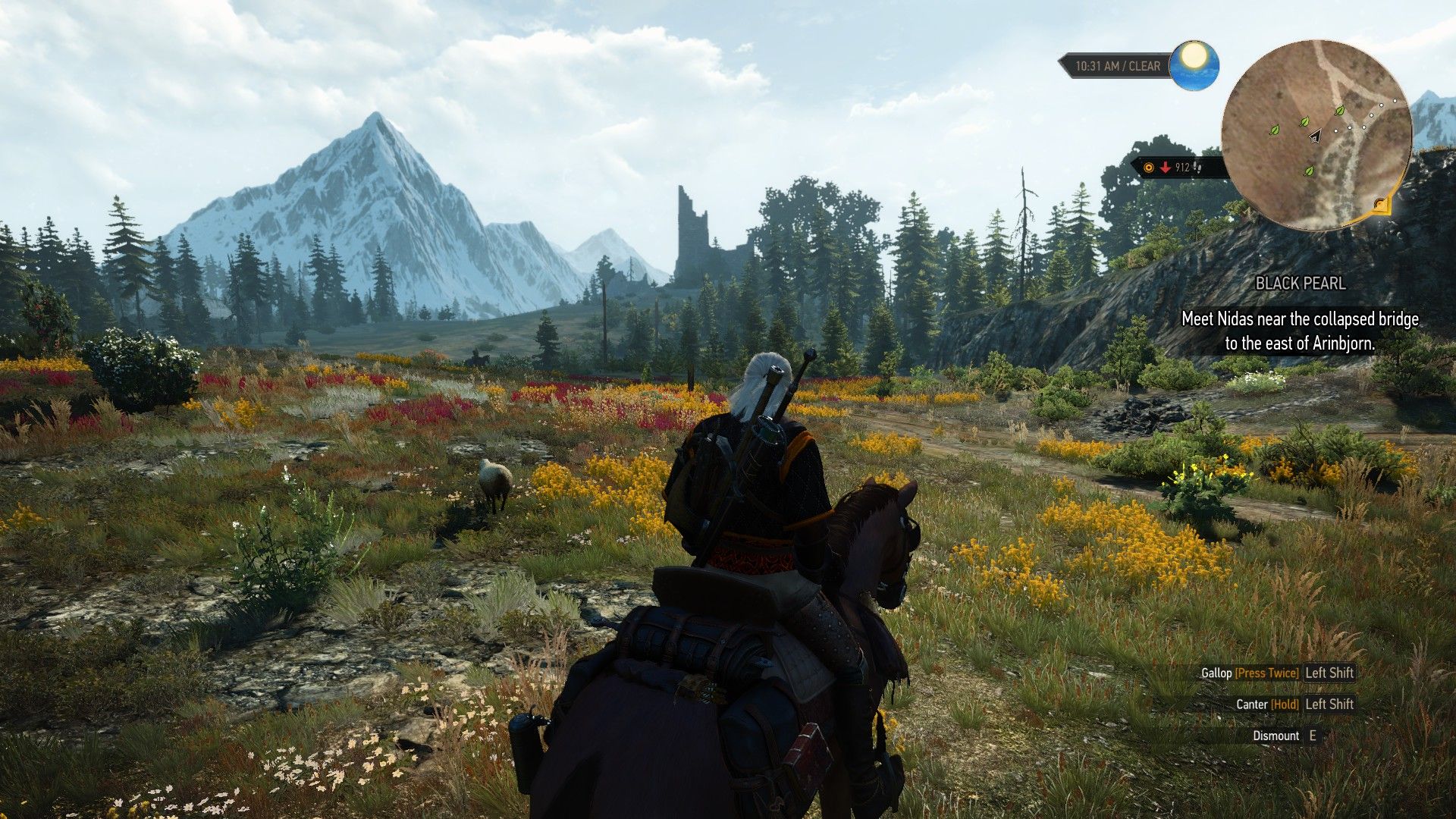
The Isles of Skellige are a breath of fresh air
Though a standout RPG for its time, the first Witcher had some of these trappings, with a rather lengthy play time that came about as a result of a lot of drawn-out fetch-quests and collectathons. The excellent sequel did away with these ‘filler’ quests almost entirely, and as a result was significantly shorter. Now after many years of development, CD Projekt Red have done the seemingly impossible: they have created a game that is much larger than both previous entries in terms of both length and geographical size, and despite this, somehow manages to steer clear of any obvious padding or filler. The Witcher 3 has a mind-boggling amount of high quality content in terms of both the main story, seemingly endless hand-crafted side quests, and also in terms of organic exploration of the game’s vast and vivacious world.
While playing the first two entries in the Witcher series will certainly help when it comes to backstory and character knowledge, the third and supposedly final Witcher game represents a more or less self-contained story. The central hook is simple; returning protagonist Geralt and his long-time love-interest Yennefer are on the trail of their long-missing ward Ciri, who is in turn being chased by the mysterious Wild Hunt. Your quest is to find her before the Hunt does. How you go about this task is anything but simple, as you trade favors for information and get embroiled in a wide variety of political, familial and cultural goings-on that will see you traveling from the countryside of Velen to the huge city of Novigrad to the Viking-themed Isles of Skellige. You will meet countless characters both new and familiar, almost all of whom have their own personalities, motivations and opinions of Geralt.
While there is no shortage of emergent activities in the game’s open world like destroying monster nests and hunting treasure based on notes or maps, the quests are the real star of the show. The story quests themselves are consistently engrossing, although you might get a bit fed up early on with the structure of exchanging favors for information. What you do within this framework is almost always interesting however, so you probably won’t mind too much. Often when the main storyline has played its course with an important character, you are given the opportunity to do further quests for them, and these optional quest lines are almost always lengthy and incredibly well designed.
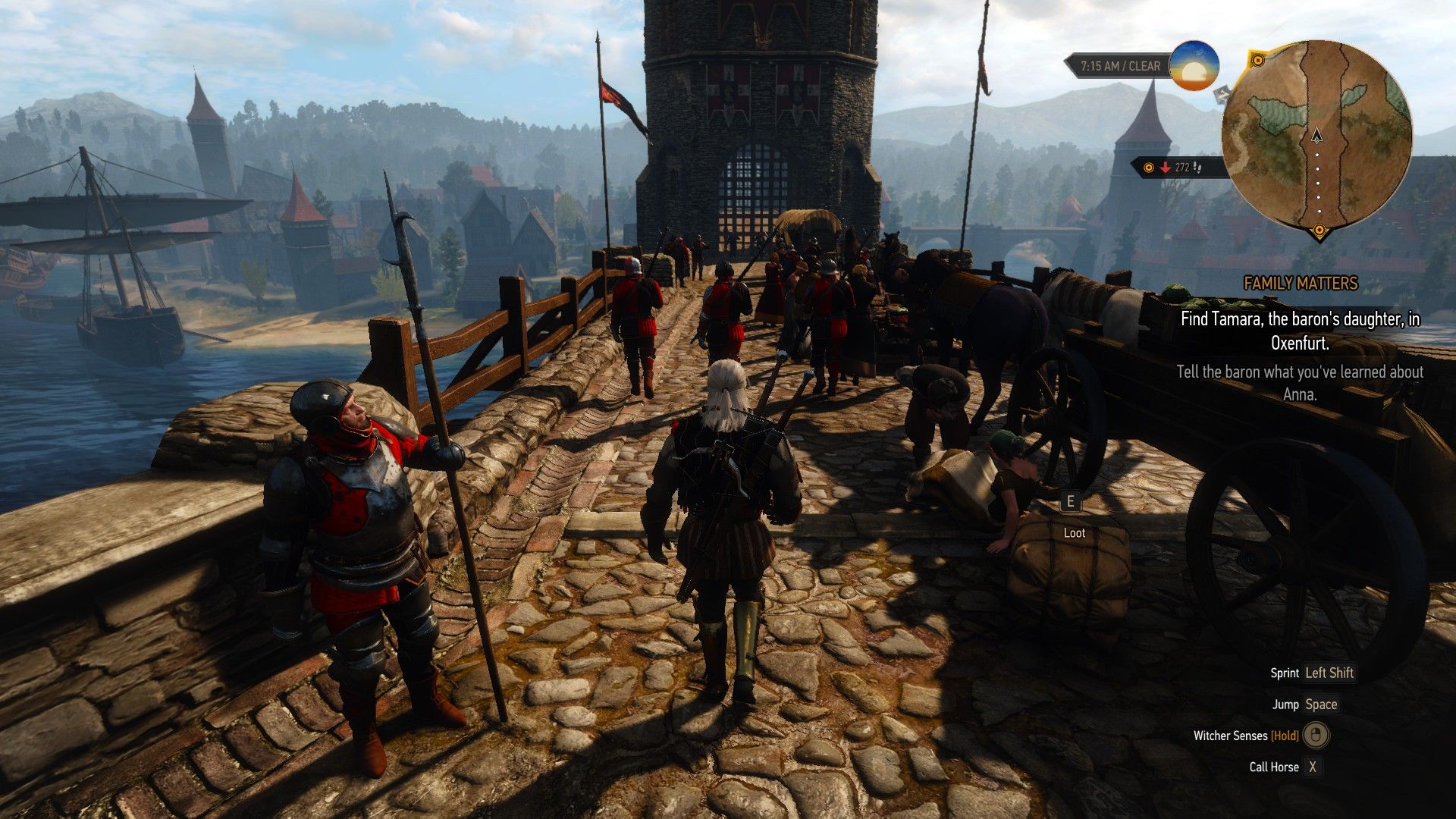
Large cities provide seemingly endless quests
A quest line that starts with you helping set up a Cabaret theater transitions into the investigation of a serial killer. You will get involved in the underground criminal factions of Novigrad, help decide the next King of Skellige, and attempt to disrupt the genocide of those who practice magic, all in secondary quests that often surpass the central storyline in quality. Later in the game, you will find that whether you chose to complete these side quests, and even how you chose to complete these side quests, will influence the main storyline. The consequences of your actions and choices are usually not immediately apparent, but if you pay attention and remember what you did previously, you will be amazed at how different side and story-quests end up interweaving later in the game.
When you move past the quests that are tied directly to the main story, you will find a seemingly endless supply of Witcher contracts and other one-off missions that are rarely as straightforward as they first seem. While not all of these side quests are home-runs, those without at least some twist, interesting hook or important choice are the exception. You never just to go a quest board, pick up a quest to kill a few monsters and then return to the quest board for a reward. Even if you do pick up a seemingly straightforward monster-killing contract, you will usually have a series of well written conversations with whoever posted the contract in the first place. When in the village where you received the quest, you will overhear the villagers talking about the monster when you arrive, and praising you if you manage to kill it.
While the quality of the quests on display is on average incredibly high, the MMO-style quest and enemy leveling system is an awkward fit for the game. Every enemy and quest has a level associated with it, and if your level is significantly higher than a given quest or enemy, the difficulty will become rather trivial. The rate at which you level up seems to be such that if you do the main story quests and the ‘prominent’ secondary quests that are tied to the story characters, you will be at around the right level to progress through the game. However as soon as you stray from this path and start completing random side quests or other activities in the open world you will quickly start to out-level the story missions. Inversely, if you focus on the story quests, you will out-level dozens of side-quests. This problem is exacerbated by the fact that the rate at which you level up only changes every ten levels, and even then by a small amount, so you actually begin to level up faster later in the game as quests grant bigger XP rewards but the amount of experience required to increase your level does not change.
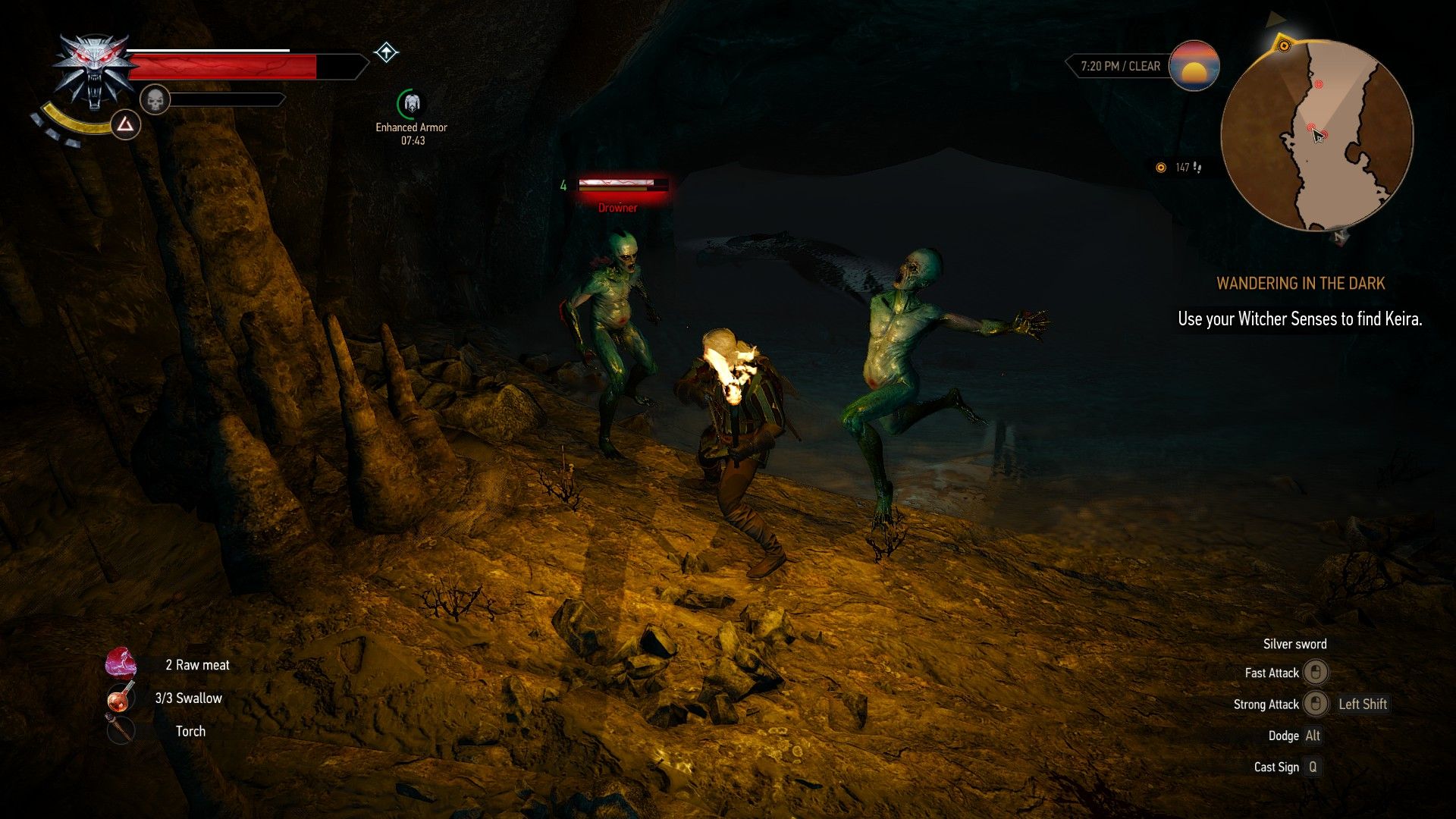
Drowners will prove Geralt's constant companions
Even stranger is the fact that lower level quests are sometimes barred behind higher level ones. For instance, the quest that first sees you sailing to the second large area of the game, Skellige, recommends that you be level 16, however once you arrive, many subsequent quests and enemies are at a lower level. The game’s difficulty feels just right for the first twenty hours or so, but assuming you spend some time exploring the open world and doing side quests and Witcher contracts there, the difficulty of the story quests and the prominent side quests are reduced accordingly. It is clear that CD Projekt Red wanted you to be able to focus on the story without having to worry about being under-leveled, but this is a disservice to the rest of the game since you aren’t given any hard incentive to go off and explore once you reach a sort of tipping point in your character’s level and strength. Fortunately, the open world activities are so enjoyable that you will want to go off and do them anyways.
While in many cases you can avoid fighting by selecting certain dialogue options, there will be times when Geralt will have to fight, against both other humans and monsters. The combat system in The Witcher 3 represents a refinement of the action-oriented mechanics of The Witcher 2. You will still dodge, parry and use signs to succeed in combat, but the mechanics have been tightened up and the action is far more fluid and enjoyable as a result. If you became frustrated with the high initial combat difficulty of The Witcher 2, you might be happy to know that the third game is less punishing early on. The most significant change is that you can now consume potions and apply weapon enhancements during combat, not just ahead of time. This means that potions and oils are infinitely more useful, which is fortunate since alchemy plays a much bigger role in The Witcher 3 than in previous Witcher entries.
How you approach any given fight is also affected by the enemy you are fighting. When going up against humans, parrying and counter-attacks are the best way to succeed. However when going up against monsters you might adjust your tactics depending on the specific enemy type. Large groups of Nekkers and Drowners must be dealt with using agility, otherwise you might get easily cornered and overwhelmed. Flying monsters can be shot out of the air with your crossbow so that you can use your silver sword to deal damage up close. Fighting larger beasts is a slower, more careful affair as you learn their attack patterns and time your strikes accordingly. Bombs, potions and spells are all useful, especially early on when Geralt is rather fragile, although after a while I found myself breezing through most fights on the first try using the same combination of spells and potions.
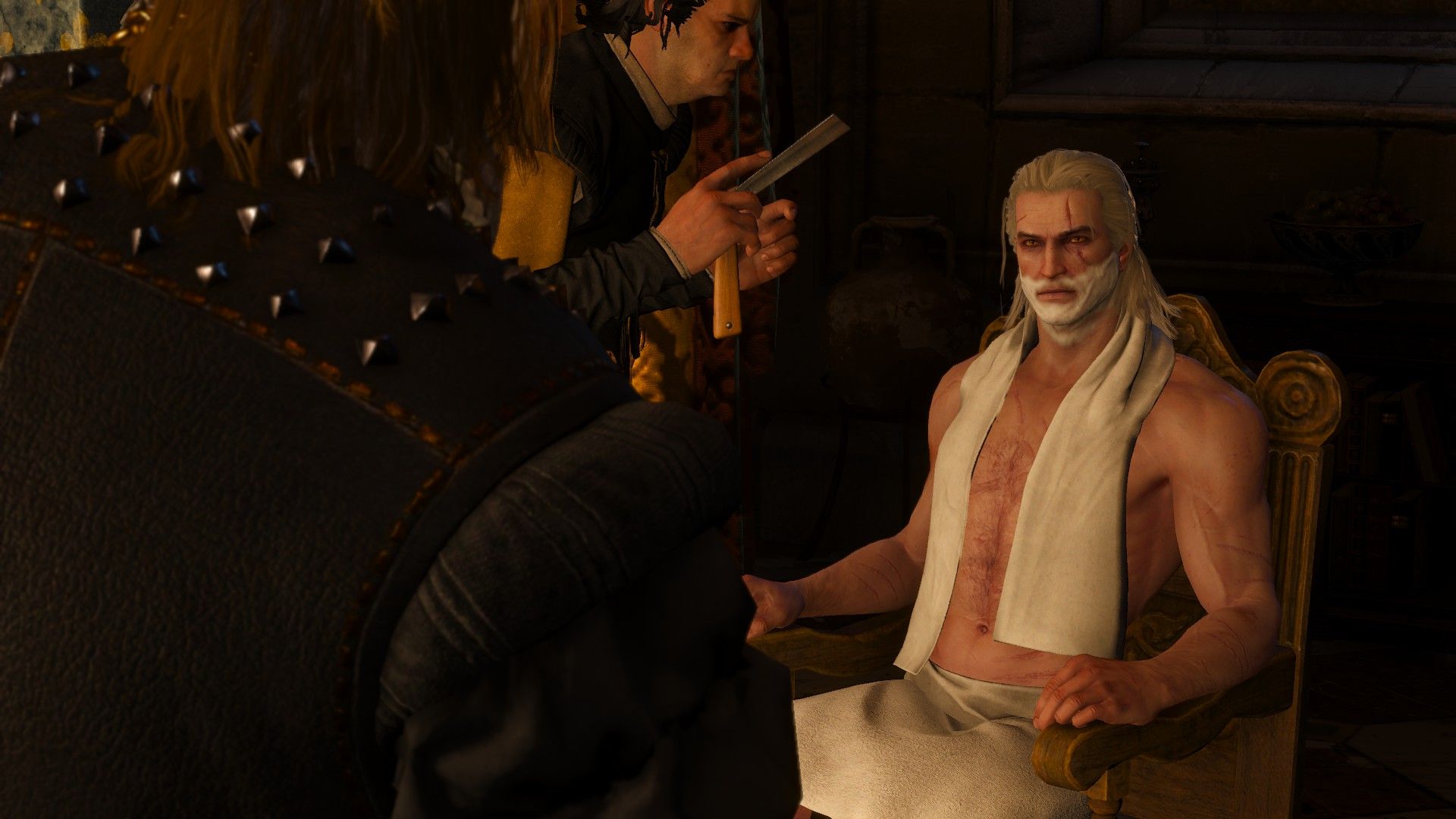
You eradicate facial hair, but it grows back in time
As an open world game, you will spend significantly more time traveling than in previous Witcher entries. When traveling to a new location you will probably use Geralt’s remarkable steed Roach, who will magically appear when you call him. Roach is a slightly unwieldy beast, performing well enough on roads but getting caught up on trees, fences, rocks and other obstacles in a rather clumsy manner. You can attempt to fight from horse-back, and when you have enough space this is a valid option, though fighting bandits on horses in cramped or forested areas can become a comical endeavor as you chase each other around. As you travel you discover sign-posts, which allow you to fast-travel to other discovered sign-posts.
Similar to the previous Witcher games, the Role-Playing aspects of The Witcher 3 come across more in the choices you make than in the way you develop your character. You can choose to put points into alchemy, spells or conventional fighting techniques, but regardless of what path you take you will still probably use bombs, spells and potions and fight in more or less the same way. Gear customization however plays a bigger role. Your stamina bar that determines how many blows you can parry or how much you can dodge also determines how quickly you can cast spells. Using heavy armor slows stamina regeneration, meaning you will probably focus more on swordplay, while lighter armour lets you dodge around and cast spells more frequently at the cost of increased fragility.
The crafting system works in much the same way as the alchemy; you will find schematics that outline what parts or ingredients you need to brew a potion or craft a piece of equipment. While Geralt can brew up a new potion at any time, you must find a smith to craft new weapons and armour. When it comes to potions, bombs and oils, you only need to collect the required ingredients once. After this, alchemy items are automatically refilled whenever you meditate, assuming you have some strong alcohol in your inventory. Many weapons and pieces of armor have rune slots that let you upgrade them in a rather Diablo-esque manner, allowing you to further improve and customize your gear. Equipment does degrade over time, and this can be a nuisance early on since you need to find a smith to make repairs, however you soon start finding weapon and armor repair kits that let you make repairs on the fly.
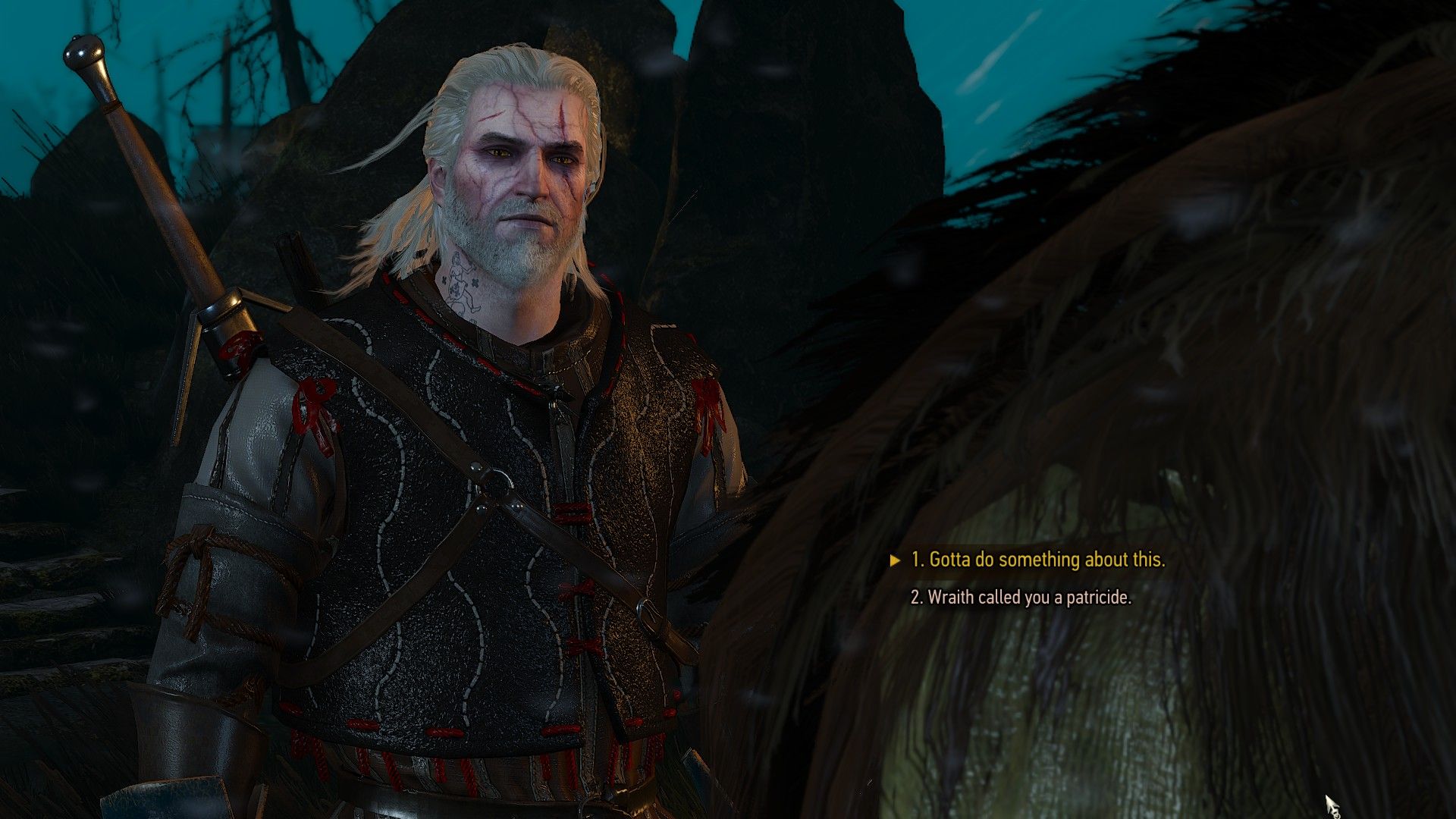
The tragic side effects of abusing Witcher potions
Another gameplay element that returns from The Witcher 2 but plays a much larger role in the third game are Geralt’s Witcher senses. Holding down a button will dampen familiar sounds like your footsteps and highlight foreign sounds like growling monsters. Objects you can interact with are highlighted, and this ability is usually used when investigating or tracking. You will frequently investigate crime scenes, or follow the tracks of a person or group of people to determine what happened to them. Whenever you stumble across something important, Geralt will bend over for a closer look and comment on whatever it is you found.
While the mechanics of investigation are pretty straightforward – look for something highlighted in red and interact with it – the stories you organically uncover while completing investigations tend to be very interesting as you discover new information. One of my favorite quests in the game involved following the tracks of a group of fighters who went off to try and kill a giant; eventually the tracks started to split up, and following the different trails eventually revealed the fate of each crew member.
Almost everything you do in The Witcher 3 has a surprising sense of gravity to it, and this can largely be attributed to the consistently excellent writing and voice acting. Between the politics, monster hunting and exploration are a lot of personal and humerous moments that lend a lot of depth and weight to the game’s world. The quiet moments, the romantic moments and the funny moments make it very easy to get invested in Geralt’s quest and the characters he interacts with, making the dark storylines and morally grey choices all that much more meaningful and at times devastating. It is this weight that allows The Witcher 3 to transcend its relatively minor mechanical shortcomings and rise above most other games in the genre.
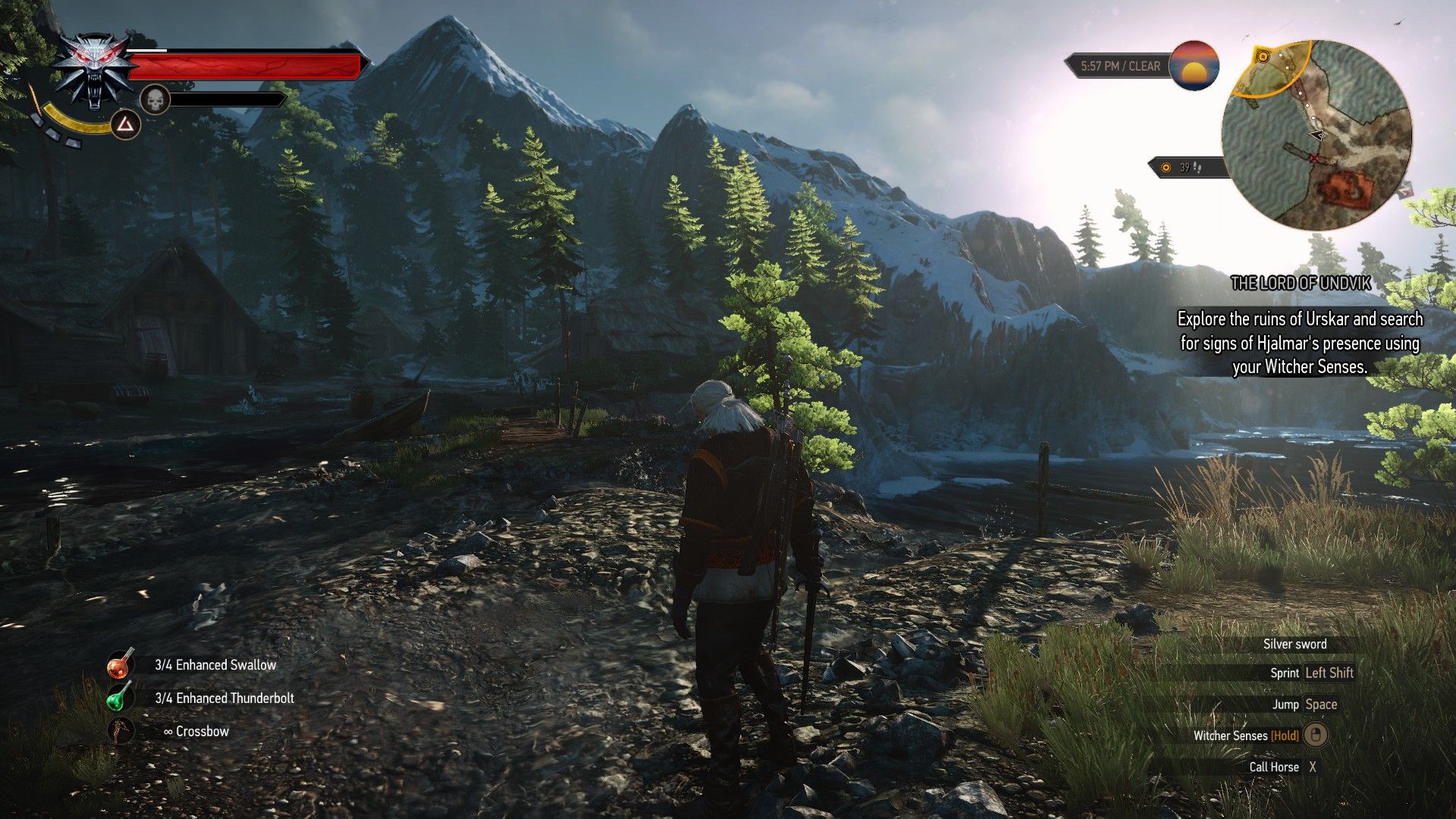
Geralt realizes he forgot to turn the stove on for dinner
The Witcher 2 was one of the best looking games of its day, and The Wild Hunt continues the tradition of outstanding visuals. Those hoping for the kind of realism found in GTA V or ArmA 3 might be disappointed, but calling the game anything short of gorgeous would be selling it short. The visuals have a painterly quality to them, with vibrant colors and great weather effects bringing the world to life. Character models and personality-laden facial animations are particularly impressive, with every bit of stubble and every pore being rendered with loving care. Scrutiny will reveal a few muddy textures and some blurry vegetation, though in normal play these weak-points aren’t noticeable. The game runs very smoothly as well, although I did experience a handful of crashes.
The sound design in the game is equally impressive; the first time you walk into a forest during a wind-storm and hear the trees cracking and leaves rustling you will surely be amazed. The original score is also a winner, with a unique mix of wailing vocals and stringed instruments adding to the atmosphere in a meaningful way. Given how long the game is, I found some of the tracks started to get repetitive after a while, particularly the more energetic tunes that play in Novigrad and some of the battle music in Velen, though this is mostly a testament to how incredibly long the game is.
The Witcher 3 has more components than I could possibly cover in a review that isn’t the length of a short novel; there is a fully fleshed-out card game called Gwent, horse racing, fist-fighting and story segments that see you playing as the elusive Ciri. Though it owes a lot to games like Skyrim and Mass Effect 2, its universe and tone is unique enough that the game manages to avoid feeling derivative. The only real problem is that you level up quickly enough that you simply cannot complete everything in the game without either the story missions or side missions becoming much lower level than your character and therefore too easy. If you have any interest at all in well thought out fantasy universes, RPG games or good storytelling, I can’t recommend The Wild Hunt highly enough; be warned though, if you are a completionist, you might have an aneurysm when you learn just how much there is to do in this game.
 Comments
Comments

















